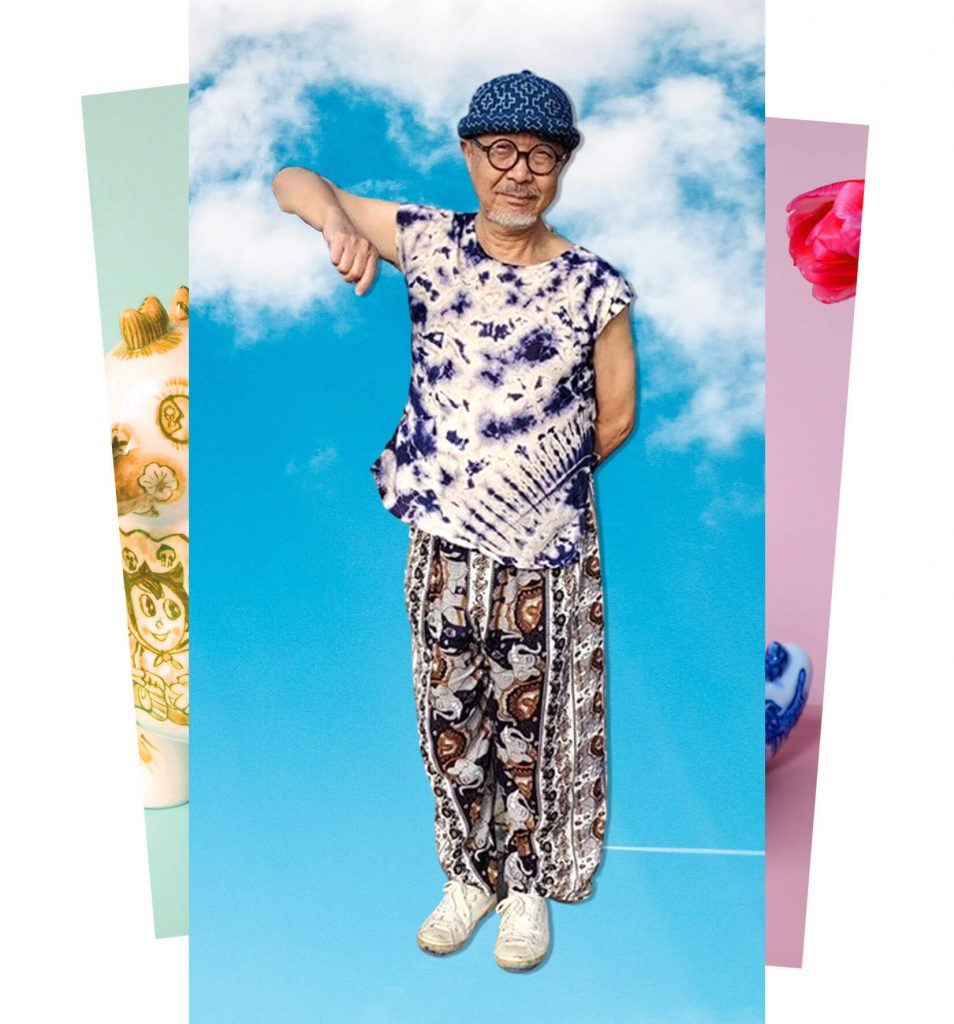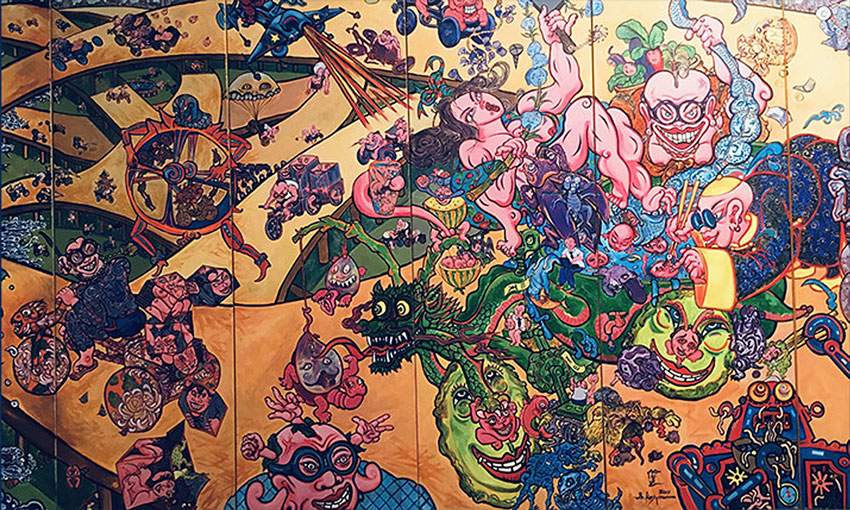| EDUCATION | |
| 2008 | Studied traditional ceramic techniques in Arita, Saga Japan |
| 2006 | Studied and worked with lithographer Satoru Itazu in Tokyo and at Queensland College of Art, Brisbane |
| 1978 | Studied at Print Workshop, London |
| 1974-78 | Travelled studying art collections in UK, France, The Netherlands |
| 1974-76 | Studied etching at Tokyo Hanga Kenkyujo. Admitted into Japan Printmakers Association |
| 1965-68 | Dokkyo University, Tokyo |
| 2014 | established studios in Arita (Japan) |
SOLO EXHIBITIONS | |
| 2015 | Ero Gro Kawaii, La Lanta Fine Art, Bangkok |
| 2013 | Ero Gro Kawaii, V Art Center, Jiaxing chaos |
| 2012 | Yume Makura, Jan Manton |
| 2010 | Heaven and Hell, Jan Manton Art, Brisbane |
| 2005 | Kiss Kiss, Ray Hughes Gallery, Sydney |
| 1989 | Sugar Cane, B&C Gallery, Gold Coast |
| 1986 | Ningyokan Gallery, Tokyo |
| 1984 | NDA Gallery, Sapporo, Japan St. Paul Gallery, Maebashi, Japan |
| 1983 | Works 1974 – 1983, Gallery 39, Sydney |
| 1979 | Gallery Wilart, The Hague, Netherlands |
| 1978 | Amsfort Gallery, Amsfort, Netherlands |
| 1971 | KFS Art Contest Grand Prix, Galleria Grafica, Tokyo |
COLLECTIONS | |
| Art Gallery of NSW Private collections Australia and overseas |

| GROUP EXHIBITIONS | |
| 2020 | Monster Again, La Lanta Fine Art, Bangkok |
| 2019 | Always Arita, SAC Art Lab, Chaing Mai |
| 2012 | International Monster Project Inaugural Show at La Lanta Gallery Bangkok |
| 2011 | Sanbao International Ceramic Museum Opening show |
| 2009 | Satellite APT, Jan Manton, Brisbane |
| 1986 | Most Promising Artist Grand Prix Print Contest, Ryu Gallery, Tokyo |
| 1980 | Kings Road Gallery, Bristol |
| 1977 | Japanese Print Association Contest Annual Exhibition, Tokyo |
| 1976 | Japanese Print Association Contest Annual Exhibition, Tokyo |
AWARDS | |
| 1975 | Japanese Print Association Contest Annual Exhibition |
| 1974 | Japanese Print Association Contest Annual Exhibition, Tokyo |
| Winner of Japan Printmakers Grand Prix, Tokyo | |
| 1971 | Winner of KFS Art Contest Grand Prix, Tokyo |
PUBLICATIONS | |
| 1974 | Illustration in Japan |
| 1973 | Illustration in Japan |
ILLUSTRATION | |
| 1971-83 | House Ilustrator for Hayakawa Mystery Magazine Various commissions for Kodansha Publications and Shimpyosha |

群馬県伊勢崎市に生まれ、繊維工場を営んでいた家族のもと、テキスタイルデザイナーとしてアーティストの道を歩み始める。フリーランスイラストレーターとして活動したのち、オーストラリアに移住し、シドニーにて版画ギャラリーをオープン。移住前には日本国内で、版画グランプリ(1974年)、講談社(1971年)をはじめ数々の賞を受賞。
作品は、現在も三宝国際陶器美術館(中国景徳鎮)やニュー・サウス・ウェールズ州立美術館(オーストラリア)、また、数多くの個人コレクションに収蔵されている。
グローバルな活動を広げるために、2013年に景徳鎮(中国)に陶磁器スタジオを設立。さらに、2014年には有田(佐賀県)、2018年にはチェンマイ郊外(タイ)にスタジオを構え、地域のアーティストと協働しながら作品のデザイン・制作・プロデュースを行っている。
作風は、日本の伝統的な紋様や浮世絵を現代的にアレンジしたもの、自身の記憶に基づいた細やかに描写された人物たち、手作業で作られた個性的で形の大胆な陶磁器オブジェ(人形)など世界でもユニークな作品群です。作品の全てに豊かな経験による即興性、一貫性のある想像力、そして情熱が表現されています。
Born in Isesaki, Japan, to a family who ran a weaving factory, Shin began his artistic path as a textile designer. After a working as a freelance illustrator, Shin moved to Australia where he established a printmaking gallery in Sydney. Before emigrating, he won numerous awards in Japan such as the Japan Printmakers Grand Prix and the KFS Art Contest Grand Prix.
Shin’s work features in the collections of the Sanbao International Ceramic Art Institute (Jingdezhen, China), the Art Gallery of New South Wales (Sydney, Australia), as well as numerous private collections.
He expanded his international activity by establishing a ceramics studio in 2013 at Jingdezhen, China. Shin also maintains studios in Arita (Saga Prefecture, Japan) since 2014 and on the outskirts of Chiangmai (Thailand) since 2018. Shin collaborates with artists in these regions to design and produce his works.
Shin’s unique oeuvre includes contemporary arrangements of traditional Japanese patterns and Ukiyo-e, detailed depictions of figures based on his own memories, as well as idiosyncratic handmade ceramic objects (dolls) with exaggerated forms. All Shin’s work expresses his inspiration earned through rich experience, along with his ceaseless imagination and passion.
History repeated.
Shin Koyama’s work requires deep contemplation. It is not something that is easily consumed. But then history rarely is. Koyama’s work draws heavily on the Japanese traditions of Emaki-mono(picture scroll), Shunga(erotic woodblock prints), and Manga(comic animation). The history involved in these art forms is extensive, and each chronicles the changing culture of Japanese society. Building upon these traditions, Koyama addresses the continuing role of the modern day artist as the recorder of events, culture, and people.
Central to all of this is Koyama’s own history as a Japanese diaspora now residing in Australia, who spends time year working in China and Japan. Koyama’s experience growing up in a rapidly changing post-war Japan is evident in the works he grapples to translate the immense depth of rich cultural history and traditions in the works. The result is captivating.
Mythology is a recurring theme in Koyama’s work as he explores traditional Japanese creatures alongside those whose appearance in history remained overlooked until Koyama unearthed them from the depths of his imagination. Koyama’s ceramic work often depicts such creatures including those from the Chinese Zodiac. Recently modern day figures have made an appearance as they themselves capture a period in time otherwise forgotten. Perhaps Koyama intends this to act as a reminder of those traditions that are declining in contemporary society, questioning the role they still might have to play.
Destruction and devastation are also repeated motifs in Koyama’s work. However the reenactment of such sentiments produces often surprising results. The 2011 Pikachan scrolls were made in reaction to the recent devastating earthquakes and tsunami in Japan. This mythical creature of Koyama’s creation is the instigator of these events, and one who takes the role of a trouble-maker seriously. Pika don is the Japanese word used to describe the atomic bomb. ‘Pika’ means brilliant light, whilst ‘don’ is used to describe the sound the bombs made. Koyama’s use of this terminology alongside the honorific word for child or friend historically places this creature in the realms of devastation experienced through the atomic age.
Koyama’s practice transcends mediums, just as his works transcend the ages. In some historic events are captured, others discuss contemporary happenings, or cultural mythologies both present and past. All act as a reminder of the importance of our past, as it creatures the basics of our present and the foundation of our future. As the recorder of history, Koyama continues to challenge ordinary perceptions and brings forth new perspectives to be considered. After all, when history is repeated there is always a new angle to contemplate.
Miriam Carter
2012
重复的历史。
Shin Koyama的作品并不太容易被读懂和理解,换言之则是需要欣赏者具备很深刻的审美观。在他的作品中很少能找到历史的痕迹,反倒在很大程度上巧妙运用了日本传统的Emaki-mono(画卷),Shunga(情色的木板画)和漫画(动画)。这些元素被大量运用到他的艺术作品中,每件作品都记录了日本社会的文化变迁。世事变迁,Koyama坚持不懈地以传统为基石,用现代艺术家独特视角记录着事件,文化和民众。
Koyama是一个日本侨民,现定居在澳大利亚,但他每年都在中国和日本工作。Koyama的成长经历是日本二战后快速发展的一个典型代表,他努力把最深厚,丰富的文化历史和传统透过作品传达给人们,并取得造诣。这正是他的作品中最核心的意义。
神话是一个被Koyama反复采用的主题,他探索着那些曾出现在日本历史中但已被忽略了的日本传统生物,Koyama凭借着他的想象力賦予了它们新的生命。Koyama的陶瓷作品常常描绘了这样的生物,其中还包括了中国生肖。若不是最新的数据已指出这些古老的生物确实在历史中占有一席之地,否则一定会被世人造忘。Koyama不斷致力于演绎这些衰退的古老生物,或许是为了提醒和质疑世人,并承认它们在现今社会中仍然可能扮演着一定的角色。
毁灭和破坏也是Koyama的作品中重复出现的主题。然而这种伤感情绪的再现却能产生出奇震撼的效果。2011年的Pikachan卷轴就是针对近期发生在日本毁灭性的地震和海啸而制作的。Koyama制作出来的神秘生物形象就是这些事件的。动者,其中一个形象就扮演着毀坏者的角色。Pikadon在日语中用来形容原子弹,‘Pika’的意为明亮的光,而‘don’是用来描述炸弹声音的。Koyama使用这个术语是为了表达对在原子时代曾遭受到严重破坏地区的孩子和朋友的尊重。
Koyama的做法已经超越了媒介,就像他的作品已超越了时代。捕提历史事件,探讨当代事件,或是过去的和现在的文化神话,所有的一切艺术表现都在提醒我们勿忘历史。因为历史既创造了现在的生活,又奠定了未来发展的方向。作为历史的记录者,Koyama继续挑战着大众观念,并为之带来一个全新的视角。毕竟,历史总是会重复,人类需要用新的观念来冥思。
Miriam Carter
2012

